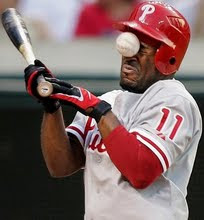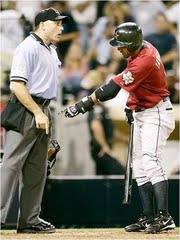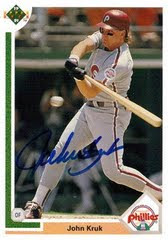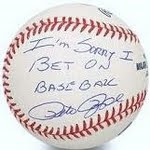In fantasy baseball, saves are overrated. With picks like Papelbon early, players pay high for 10% (in a 5x5 standard) of their impact points. When four category players like Curtis Granderson are still on the board, it is silly to waste a pick on a guy who will surely rack up saves and slightly help your ratios when you know that late in the draft there will be no 3/4 category players left, buts still plenty of guys who will get you saves and not hurt your ratios.
In the large scheme of things, the average RP tosses what, 70 innings? Most players employ 2-3 closers, depending on both the quality and availability of closers in the draft/free agency pool. Even with 3 guys, the average total impact of those relievers would be 210 IP, the innings equivalent of what a top 30 starter would toss. Assuming an 1800 IP limit that come standard in a Yahoo roto league, that cumulative 210 IP comprises less than 12% of your team's total innings allocation. A combined RP core with a 3.00 ERA, 180 K, 210 IP, 1.10 WHIP line (with some scattered Ws here and there) would slightly help a team whose starting pitching core were to average a 3.75 ERA, 165 K, 1.3 WHIP and 190 IP per SP (based on what it takes to win according to Roto Authority) by boosting some average ratios, but how much would adding an inferior RP core that racked up a comparable amount of saves across the same IP hurt a team?
Let's say instead of drafting Papelbon, Mariano Rivera and Bobby Jenks (a combined 120 SVs) last year, you drafted Brian Wilson, Kevin Gregg and George Sherrill (a combined 102 SVs)? You would not necessarily clear the saves category for 10 points, but you would still be in a prime position to rack up respectable saves numbers with late round draft picks. While last year Papelbon (49 ADP), Rivera (72 ADP) and Jenks (107 ADP) combined for a valuable 2.11 ERA (47 ER), 14 W, 120 SV, 192 K, .90 WHIP line across roughly 202 IP, Gregg (292 ADP), Sherrill (237 ADP) and Wilson (155 ADP) combined for a 4.41 (90 ER), 13 W, 102 SV, 183 K, 1.40 WHIP in about 184 IP. While the latter groups line isn't nearly as pretty as the elite RP's line, the variance between the two groups is much more overstated that you'd expect, based on 2009 ADP.
quick sidenote: obviously some changes to this grouping would need to be made on the basis of facts like Sherrill being replaced by Chris Ray midseason or Kevin Gregg not being the closer (even though he should, allowing the Cubs to continue to maximize Marmol's use in high leverage situations), but these guys could easily be substituted for late round 2009 closers like Chad Qualls (204 ADP) or Joel Hanrahan (198 ADP); the general point of this argument remains the same.
As you might observe, the difference in counting stats productions between these two groups of RPs in 2008 was somewhat negigible. 9 Ks and 1 W is more the byproduct of circumstance than opportunity. As noted earlier, being 18 SVs short of 3 of the top 5 closers going into 2008 with late round picks would put you in prime position to stay competitive in the SVs category.
The combined line of the elite RP core would surely improve your teams ratios to better approach "what it takes to win", but at the cost of 3/4 category offensive guys. On the other hand, the 4.40 ERA over 184 IP accumulated by the inferior RP core would constitute a 10.2% impact on all 1800 IP, causing a 3.75 ERA line to rise to 3.81. By contrast, the elite RP core's impact would constitute 11.2% of all IP and lower ERA from 3.75 to a 3.56 line. A similar impact is observable on WHIP (the elite RP core lowers whip to 1.25, the inferior RP core increases WHIP to 1.31).
What we can observe here is that while the elite RP core does positively impact pitching statistics, the inferior RP core simultaneously NEGLIGIBLY impacts the pitching line -- while the superior RP core lowers ERA well below the projected "what it takes to win" threshold (while also lowering WHIP a sizeable chunk), the inferior RP core only increases ERA by .06 and whip by .01. With smart drafting of SPs (who have much more impact on cumulative pitching statistics than RPs, mind you), this tiny impact of the inferior RP core could easily be offset, while gaining the benefit of a 3/4 category hitter or two early in the draft (by forgoing the elite RP in favor of an "inferior one").
What is very roughly observable here is the overrated impact of RPs based on draft position. Inferior RPs can easily put up comparable counting stats without hurting your ratios if you draft smart. Comparatively, late game hitters (minus sleepers, which can be harder to effectively forecast) generally cannot produce comparable offensive numbers to early round hitters. Come picks 180+, the hitters left in the pool are generally one category guys and offensive gambles. If you go with an early RP, late hitter strategy, you are maximizing risk (by forgoing more reliable/valuable hitters) and minimizing overall return, which is somewhat irrational in the investment game known as drafting. Smarter investment would call for the strategy of simply ignoring RPs until the later rounds (or just ignoring saves all together and focusing on the other 9 categories; why not try maximizing 90% of your potential against balancing 100%? It is equally as viable if done properly).
A lot of this knowledge is "conventional wisdom" for baseball drafters; I'm just putting some rough numbers behind the assertion. Now that that is established, let's move on to the point of my post: rules of thumb for drafting Closers (btw, I should go back in my post to modify all references to RPs as CLs, but you can infer what I mean and as I mentioned earlier, I'm lazy).
If it isn't obvious by now, I think closers are overrated. I rarely draft them (because so many guys lose their jobs midseason), but when I do, I like to look for bargains. I look for guys who meet the following criteria (in this order):
1) Job security
2) Save opportunity potential
First and foremost, if you are going to draft a closer, you want to draft a guy who is going to close. Why waste a pick on a guess (ie, who is closing in Seattle for 2009) when you can probably pick up the person who the closer out of spring training loses the job to off of waivers within a week or two? Why also waste a pick on a closer who has a better RP who may unseat him from the closing role behind him? To me, it seems like a waste of a pick that you could spend gambling on a guy like Denard Span or Shin-Soo Choo.
Secondly, I like a guy who is going to get the chance to save games. This doesn't mean a closer for an offensive friendly team like the Red Sox or Yankees, but closers for teams like The Pirates and Royals, where every one of their 70 wins per season is a save opportunity. Last year, I got Matt Capps, Joakim Soria and Brian Wilson at incredibly discounted prices and they paid off big time.
If you want my recommendation of who to draft, I'd recommend Brandon Lyon (because no one in Detroit is really healthier than him who can throw strikes), Brian Wilson (who has great stuff and no one to unseat him), Heath Bell (the Padres are notoriously committed to keeping their closer the closer during the season, no matter how hard he struggles) and Grant Balfour (the healthier, younger, better option for Tampa; Balfour for Closer is as inevitable as was Obama for President).
That's all for now; it's late and I'm tired. Apologies for spelling/grammar errors; I just wrote this from beginning to end in one sitting and am (yes, you guessed it) too lazy to re-read/edit tonight.
What we can observe here is that while the elite RP core does positively impact pitching statistics, the inferior RP core simultaneously NEGLIGIBLY impacts the pitching line -- while the superior RP core lowers ERA well below the projected "what it takes to win" threshold (while also lowering WHIP a sizeable chunk), the inferior RP core only increases ERA by .06 and whip by .01. With smart drafting of SPs (who have much more impact on cumulative pitching statistics than RPs, mind you), this tiny impact of the inferior RP core could easily be offset, while gaining the benefit of a 3/4 category hitter or two early in the draft (by forgoing the elite RP in favor of an "inferior one").
What is very roughly observable here is the overrated impact of RPs based on draft position. Inferior RPs can easily put up comparable counting stats without hurting your ratios if you draft smart. Comparatively, late game hitters (minus sleepers, which can be harder to effectively forecast) generally cannot produce comparable offensive numbers to early round hitters. Come picks 180+, the hitters left in the pool are generally one category guys and offensive gambles. If you go with an early RP, late hitter strategy, you are maximizing risk (by forgoing more reliable/valuable hitters) and minimizing overall return, which is somewhat irrational in the investment game known as drafting. Smarter investment would call for the strategy of simply ignoring RPs until the later rounds (or just ignoring saves all together and focusing on the other 9 categories; why not try maximizing 90% of your potential against balancing 100%? It is equally as viable if done properly).
A lot of this knowledge is "conventional wisdom" for baseball drafters; I'm just putting some rough numbers behind the assertion. Now that that is established, let's move on to the point of my post: rules of thumb for drafting Closers (btw, I should go back in my post to modify all references to RPs as CLs, but you can infer what I mean and as I mentioned earlier, I'm lazy).
If it isn't obvious by now, I think closers are overrated. I rarely draft them (because so many guys lose their jobs midseason), but when I do, I like to look for bargains. I look for guys who meet the following criteria (in this order):
1) Job security
2) Save opportunity potential
First and foremost, if you are going to draft a closer, you want to draft a guy who is going to close. Why waste a pick on a guess (ie, who is closing in Seattle for 2009) when you can probably pick up the person who the closer out of spring training loses the job to off of waivers within a week or two? Why also waste a pick on a closer who has a better RP who may unseat him from the closing role behind him? To me, it seems like a waste of a pick that you could spend gambling on a guy like Denard Span or Shin-Soo Choo.
Secondly, I like a guy who is going to get the chance to save games. This doesn't mean a closer for an offensive friendly team like the Red Sox or Yankees, but closers for teams like The Pirates and Royals, where every one of their 70 wins per season is a save opportunity. Last year, I got Matt Capps, Joakim Soria and Brian Wilson at incredibly discounted prices and they paid off big time.
If you want my recommendation of who to draft, I'd recommend Brandon Lyon (because no one in Detroit is really healthier than him who can throw strikes), Brian Wilson (who has great stuff and no one to unseat him), Heath Bell (the Padres are notoriously committed to keeping their closer the closer during the season, no matter how hard he struggles) and Grant Balfour (the healthier, younger, better option for Tampa; Balfour for Closer is as inevitable as was Obama for President).
That's all for now; it's late and I'm tired. Apologies for spelling/grammar errors; I just wrote this from beginning to end in one sitting and am (yes, you guessed it) too lazy to re-read/edit tonight.







5 comments:
then why did you draft valverde in the 10th wood in the 14th and wilson in the 20th?
are you watching eastbound and out? cause it's the funnies show ever
I drafted many, many closers because
1) I thought it'd be fun
2) I wasn't going to draft who I wanted and give any tips away to you guys ;)
havent seen it yet; where can i watch?
You know, You make a very compelling argument and use great data to support your claim
Yet, despite this I think Ill draft CL high anyway.
In retrospective, all of this, short of my comments on Kevin Gregg and Grant Balfour, remained true.
Post a Comment